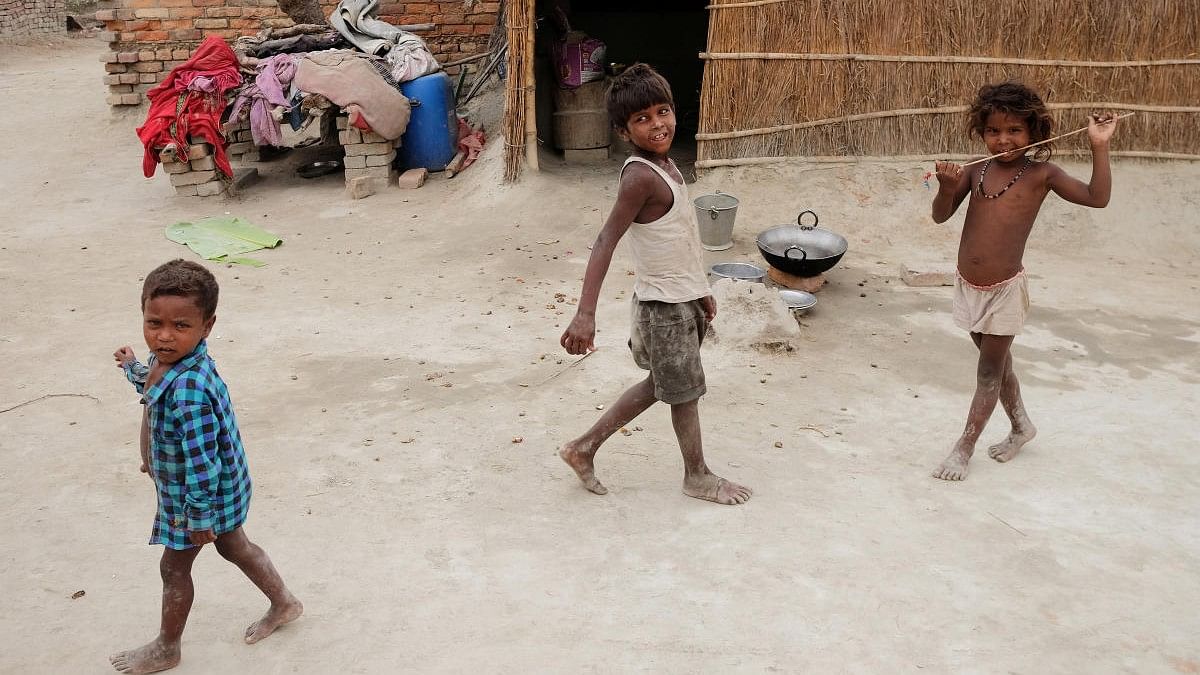
Nutritional indicators for children under five years of age measured by stunting stood at 35.5 per cent, wasting at 19.3 per cent, and underweight prevalence at 32.1 per cent as per the National Family Health Survey-5. Representative image.
Credit: Reuters Photo
While presenting the Interim Budget for 2024-2025, Finance Minister Nirmala Sitharaman envisioned a ‘Viksit Bharat’ — transforming India into a developed nation by 2047. But with the largest global population of undernourished (234 million out of 725.1 million in 2020-2022), how can India aspire to be Viksit?
At the country level, nutritional indicators for children under five years of age measured by stunting stood at 35.5 per cent, wasting at 19.3 per cent, and underweight prevalence at 32.1 per cent as per the National Family Health Survey-5.
Sitharaman emphasised improving nutrition delivery, early childhood care, and development through upgrading Anganwadi centres under the Saksham Anganwadi and Poshan 2.0. This scheme, formerly called the Umbrella Integrated Child Development Scheme (ICDS) is allocated Rs 21,200 crore — that’s 1.5 per cent lower than last year’s revised estimates.
The Pradhan Mantri Poshan Shakti Nirman scheme, earlier known as Mid-Day Meal (MDM) scheme saw an increase in budget allocation from Rs 11,600 crore in 2023-2024 to Rs 12,467 crore in 2024-2025. However, around 14 per cent of the funds allocated in FY2024 were unutilised compared to its budget estimates. Food subsidy was allocated Rs 2.05 lakh-crore in 2024-2025, lower than revised estimates of Rs 2.12 lakh crore in 2023-2024. The government has extended the PMGKAY scheme for another five years, by providing subsidised rice and wheat for free to 800 million Indians.
Despite large-scale food safety programmes, improvement in the nutritional status of the population has been sluggish and micro-nutrient deficiencies have increased. Between 2015-2016 (NFHS-4) and 2019-2021 (NFHS-5), the prevalence of anaemia among children aged 6-59 months increased from 59 per cent to 67 per cent. Anaemia among women aged 15-59 years increased from 53.1 per cent to 57 per cent, whereas among pregnant women, it increased from 50.4 per cent to 52.2 per cent during the same period. But, the first 1,000 days between a woman’s pregnancy and her child’s second birthday have a significant impact on her child’s cognitive and physical development.
In 2018, the Union government implemented Anemia Mukt Bharat (AMB) to reduce the prevalence of anaemia in women, children, and adolescents through a life cycle approach. The scheme aims to reduce anaemia through iron-folic acid supplementation; deworming among children; providing Iron and Folic Acid (IFA) through public health schemes; intensified year-long behavioural change campaigns as well as addressing non-nutritional causes of anaemia in endemic pockets.
The World Health Organization (WHO) recommends a daily supplementation of IFA for at least 180 days during pregnancy as a part of antenatal care to mitigate the risk of low birth weight, maternal anaemia, and iron deficiency. Pregnant women consuming IFA for 180 days increased from 14.4 per cent to 26 per cent between 2015-2016 to 2019-2021. However, the AMB initiatives need to urgently focus on behavioural change through health and nutrition education to prevent anaemia and promote maternal and child health.
Given these challenges of malnutrition, how to realign budgetary allocation to make India viksit?
First, educated women are less likely to be anaemic, as education improves nutrition and knowledge about dietary and childcare practices. The fiscal outlay towards women's education under Samagra Shiksha, an overarching school education programme under the National Education Mission, is Rs 37,500 crore in FY2025 (lower than the budget estimates of the previous year in real terms). Notably, more than 17 per cent of the total budget allocated for the SAMBAL scheme inclusive of Beti Bacho, Beti Padhao which promotes girl child’s education, was not utilised during FY2024. The unutilised funds could be allocated to promote higher education among women through better-targeted scholarship programmes spanning from senior secondary school to graduation.
Our major food safety nets are biased toward staples which often lack the essential micronutrients required for normal human growth. This necessitates reforming the current public distribution system (PDS) towards a diversified and nutritious basket. One way could be to utilise the built-in provisions of the National Food Security Act (2013) through which households could be given a choice-based system to opt for subsidised foodgrains or conditional cash transfers. Alternatively, a centralised system could issue inflation-indexed cash entitlement vouchers through existing PDS outlets, providing beneficiaries to make dietary choices based on their diet preferences and requirements.
Another cost-effective and sustainable solution to improve micronutrient intake among populations with limited access to diverse diets and other micronutrient interventions is through biofortification. Scaling up biofortification in staple crops on a large scale can effectively address chronic malnutrition in India by introducing nutrient-rich varieties. Further supplementing school lunches under MDM scheme with double-fortified salt (iron and iodine) and iron and zinc-fortified staples can reduce micronutrient deficiencies among children.
The government needs to dovetail its policies and budget towards these innovative solutions to move towards not only a developed (viksit) but also a nourished (paushitk) India.
(Kriti Khurana is PhD scholar at BITS-Pilani, Hyderabad. X: @KritiKhurana12. Shyma Jose is Assistant Professor, Jesus and Mary College, Delhi University. X: @Shyma_jose.)
Disclaimer: The views expressed above are the author's own. They do not necessarily reflect the views of DH.